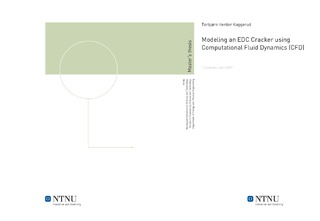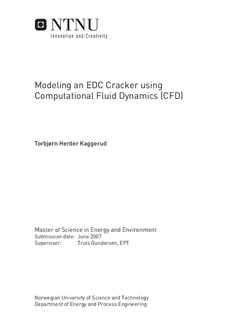| dc.contributor.advisor | Gundersen, Truls | nb_NO |
| dc.contributor.author | Kaggerud, Torbjørn Herder | nb_NO |
| dc.date.accessioned | 2014-12-19T11:44:29Z | |
| dc.date.available | 2014-12-19T11:44:29Z | |
| dc.date.created | 2010-09-04 | nb_NO |
| dc.date.issued | 2007 | nb_NO |
| dc.identifier | 348459 | nb_NO |
| dc.identifier | ntnudaim:3745 | nb_NO |
| dc.identifier.uri | http://hdl.handle.net/11250/233638 | |
| dc.description.abstract | The process used by the Norwegian company Hydro for making Vinyl Chloride Monomer (VCM) from natural gas and sodium chloride has been studied. A three dimensional CFD model representing the firebox of the EDC cracker has been developed using the commercial CFD tool Fluent. Heat to the cracker is delivered by means of combustion of a fuel gas consisting of methane and hydrogen. In the developed CFD model used in this work, the combustion reaction itself is omitted, and heat is delivered by hot flue gas. With the combustion reaction left out, the only means of tuning the CFD model is through the flue gas inlet temperature. With the flue gas inlet temperature near the adiabatic flame temperature, the general temperature level of the EDC cracker was reported to be too high. The outer surface temperature of the coil was reported to be 3-400 K higher than what was expected. By increasing the mass flow of flue gas and decreasing the temperature, the net delivered heat to the firebox was maintained at the same level as the first case, but the temperature on the coil was reduced by 100-150 K. Further reductions in the flue gas inlet temperature and modifications in the mass flow of flue gas at the different burner rows, eventually gave temperature distributions along the reaction coil, and flue gas and refractory temperatures, that resemble those in the actual cracker. The one-dimensional reactor model for the cracking reaction represents the actual cracker in a satsifactorily manner. The cracking reaction was simulated using a simple, global reaction mechanism, thus only the main components of the process fluid, EDC, VCM and HCl, can be studied. The model is written in a way suitable for implementation of more detailed chemical reaction mechanisms. The largest deviation in temperature between measured and simulated data are about 5%. At the outlet the temperature of the process fluid is equal to the measured data. The conversion of EDC out of the firebox is assumed to be 50 wt-%, this value is met exactly by the model. | nb_NO |
| dc.language | eng | nb_NO |
| dc.publisher | Institutt for energi- og prosessteknikk | nb_NO |
| dc.subject | ntnudaim | no_NO |
| dc.subject | SIE5 energi og miljø | no_NO |
| dc.subject | Varme- og energiprosesser | no_NO |
| dc.title | Modeling an EDC Cracker using Computational Fluid Dynamics (CFD) | nb_NO |
| dc.type | Master thesis | nb_NO |
| dc.source.pagenumber | 82 | nb_NO |
| dc.contributor.department | Norges teknisk-naturvitenskapelige universitet, Fakultet for ingeniørvitenskap og teknologi, Institutt for energi- og prosessteknikk | nb_NO |

